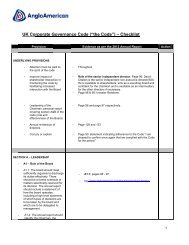pdf [ 1.1MB ] - Anglo American
pdf [ 1.1MB ] - Anglo American
pdf [ 1.1MB ] - Anglo American
Create successful ePaper yourself
Turn your PDF publications into a flip-book with our unique Google optimized e-Paper software.
2.163.7 | 3.15 | 3.16 | 3.20EN3 | EN4 | EN5 | EN6 | EN7EN8 | EN11 | EN12 | EN14EN16 | EN17 EN18 | EN23EN27 | EN29 | EN30Water used for primary activitiesMillion m 354321002 03 04 05YearTotal energy useMillion GJ654321002 03 04 05YearLeft: Kenneth Mokoenaexamines indigenous plantsremoved from the wetlandlocated in the Isibonelo miningarea and preserved in anursery until they arereplanted during the futurerehabilitation process.ANGLO COAL SOUTH AFRICA hasidentified the following areas aspotentially high environmental risksfor the division:ooooooooenvironmental legal non-compliance;major pollution incidents;ground and surface water pollution;atmospheric emissions;tailings and waste rock dumps;hazardous waste management;loss of land capability in mining disturbedareas; andthe negative consequences of loss ofISO 14001 certification.The implementation of ISO 14001 has effectivelyreduced these risks in most areas to acceptablelevels, as agreed in partnership with the regulatoryauthorities. The cost of water treatment and legalnon-compliance caused by water discharges remainpotentially high-risk and we continue to seek solutionsto these with government. Similarly, spontaneouscombustion is a specific issue that has receivedfocused attention.During 2005, <strong>Anglo</strong> Coal conducted its threeyearlyclosure costing review of all operationalcollieries, assisted by external quantity surveyorsVenn & Milford. The exercise included a reassessmentof planned closure costs, as well as an assessmentof the current rehabilitation liability, to determinethe gap between the current liabilities and thecurrent balance in the environmental rehabilitationtrust fund. The findings of this study will be availableduring 2006.EnergyOur greatest energy consumption is in the form ofelectricity and liquid fossil fuels used to power theheavy machinery on our mines. In 2005, ourconsumption was 90MJ per saleable tonne, whichwas 6% above the target set for the year. <strong>Anglo</strong><strong>American</strong> plc has committed to reducing energyintensity by 15% within 10 years. One of thereasons for not meeting the target is the factthat diesel consumption, in explosives and bycontractors, was not previously captured and hasnow been included.Since the company’s energy strategy waspublished in 2004, energy committees have beenformed on all mines to implement this strategy.They are raising awareness of where energy ispotentially wasted in every-day applications on themines, and will be implementing best practiceenergy efficiency running of machinery at atechnical level.An energy awareness booklet will be publishedin mid-2006 to encourage employees across allmines to watch constantly for unnecessary energyuse. <strong>Anglo</strong> Coal South Africa is working withdemand-side management consultants to establishenergy consumption baselines and to identify energysavings and efficiency projects. Some such projectsinclude:ooooptimising underground ventilation fanpositioning;solar water heating of geysers in mine villages;andoptimising plant and pit pumps by using themat their optimum efficiency, introducing powercorrection factors and employing variablespeed drives.WaterThe mining and beneficiation of coal are waterintensive activities. The average annual consumptionfor <strong>Anglo</strong> Coal South Africa for 2005 was 40 litresper saleable tonne, well within the target of 45 litresper tonne. The target for 2006 is 39 litres per saleabletonne, 3% down on the actual usage in 2005.All collieries have submitted Water Use LicenseApplications to the Department of Water Affairs andForestry (DWAF).New Denmark colliery’s application to disposeof brine from the reverse osmosis plant at Eskominto the 321 underground compartment was approved25


![pdf [ 1.1MB ] - Anglo American](https://img.yumpu.com/49057963/27/500x640/pdf-11mb-anglo-american.jpg)
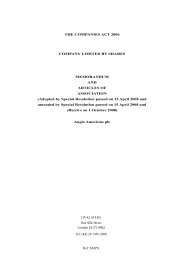
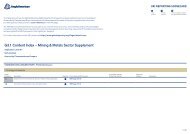
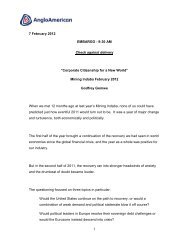
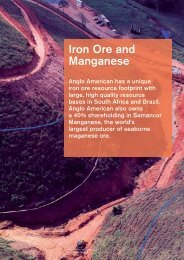
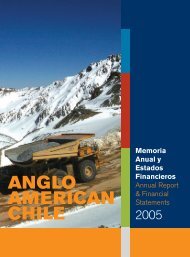
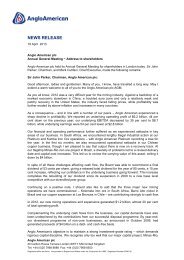
![English PDF [ 189KB ] - Anglo American](https://img.yumpu.com/50470814/1/184x260/english-pdf-189kb-anglo-american.jpg?quality=85)
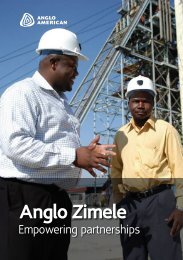

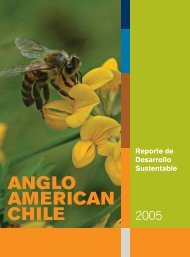

![pdf [ 595KB ] - Anglo American](https://img.yumpu.com/49420483/1/184x260/pdf-595kb-anglo-american.jpg?quality=85)
